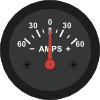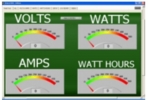


| **These are clickable page links** | ||
| HOME | TECH INFO | SPECIALS |
| FRIDGES | SOLAR | INVERTERS |
| CHARGERS | BATTERIES | OTHER |
| CONTACT | FIND US | LINKS |
| Please share this page
with your friends >>
G'day
folks, lets see if we can make these muddy waters a little
less muddy. I think it's easier to understand if I give you some easy examples to work through. For the sake of this explanation lets say you have a 12 volt fridge with a compressor motor, and this fridge draws 5 amps while it's compressor motor is actually running, now if the compressor motor ran continuously for the whole hour, the fridge will have drawn 5 amps in total for that hour, and we express this as 5 Amp-Hours (5Ah), and so if it ran like this continuously for 24 hours, it would have drawn and consumed a total of 120 Amp-Hours (5Ah x 24h = 120Ah). However the fact is the compressor motor should not ever be running continuously for the whole 24 hours, it should cycle on and off as required to keep the fridge at a constant temperature, to whatever you have set it to in the fridge, so now if it was running on say a 50% duty cycle, i.e. running on and off for a total of only 1/2 an hour running in total within that hour, it would still be drawing 5A while it's running, but seeing it's running for only half of the hour, it's total power consumption for the hour would now be just 2.5Ah, and just 60Ah over a 24 hour period (2.5Ah x 24h = 60Ah). So
along these lines lets look at say an electric 12 volt water pump,
while it
may draw 10A
when it's running, Watts that you say? Ok some electrical appliances are rated in Watts rather than Amps, but that's ok, it's easy to convert these Watts to Amps. You
simply take the stated Watts,
and divide that by the Voltage
and this gives you the Amps
that the item will draw This also works the other way around, if you have the amps and the voltage of an item and you want to know the Watts, simply multiply the amps by the voltage and you have the Watts. So for example remember that water pump that was drawing 10A at 12V, well 10A x 12V = 120Watts
So if you had a 2400W room heater, at 240V = 10A, and this just happens to be the most you can draw out of a standard household power point, 10A or 2400W. Inverters When
trying to work out how much power will be drawn from your batteries by
an inverter, a very rough but easy calculation is for every 100W
at 240V,
you can expect the inverter will draw about 10A at 12V
from your batteries, it really works out a bit
less than this but it's close enough for doing quick calculations.
|
Copyright © FRIDGE & SOLAR. since 2002